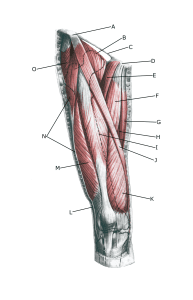Anatomy
In principle, any muscle on the thigh can rupture, but most commonly the anterior thigh muscle (quadriceps femoris muscle), whose function is to extend the knee and bend the hip. The anterior thigh muscle consists of four muscles (M vastus lateralis, M vastus medialis, M rectus femoris and the deep M vastus intermedius).
 Thighs from the front:
Thighs from the front:
A. Spina iliaca anterior superior
B. M. iliopsoas
C. Lig. inguinal
D. Tuberculum pubicum
E. M. pectineus
F. M. adductor longus
G. M. gracilis
H. M. adductor magnus
I. M. rectus femoris
J. M. sartorius
K. M. vastus medialis
L. Tractus iliotibialis
M. M. vastus lateralis
N. M. tensor fasciae latae et tractus iliotibialis
O. M. gluteus medius
Cause
When one of the thigh muscles is subjected to a load that exceeds the strength of the muscle (jumping, kicking), a rupture occurs. The vast majority of thigh injuries occur when the thigh is stretched while the muscle is contracted (eccentric contraction), for example in a kick or push-off.
Injuries in muscles can be localised in the muscle tissue itself, in the fascia around/between the muscles or in the tendon part of the muscles, which has a major impact on prognosis (muscles heal much faster than tendons).
Most ruptures are partial muscle tears. The rupture is often accompanied by painful bleeding, which may increase after a few days due to the formation of a hygroma.
Symptoms
In mild cases, a localised soreness is felt after the strain (‘muscle strain’, ‘threatening fibre’). In more severe cases, a sudden shooting pain is felt in the muscle (‘partial muscle rupture’, ‘fibre tear’). In the worst case, a violent pop is felt, after which it is impossible to use the muscle (‘total muscle rupture’). Muscle haemorrhaging after a direct blow to the thigh is called a ‘tear’. In muscle injuries, the following three symptoms are characteristic: Pain when pressing, stretching and activating (stretching the knee) against resistance.
With total tears, a defect in the muscle can often be seen and felt, and a swelling (the contracted muscle bulge and bleeding) is felt above or below the tear. Most commonly, muscle tears occur on the thigh about 10 cm below the anterior superior iliac crest (spina iliaca anterior superior) in the rectus femoris muscle. The haemorrhage can become so severe that it causes increasing pain and risks triggering acute musculoskeletal syndrome (compartment syndrome).
Examination
In mild cases with only minimal soreness and no discomfort during normal walking, a medical examination may not be required. However, the severity of soreness is not always a measure of the extent of the injury. If there is more pronounced soreness and loss of strength in the thigh, a medical examination is advised to ensure diagnosis and treatment. Diagnosis is usually made by a general clinical examination. If there is any doubt about the diagnosis, ultrasound or MRI scans may be performed.
See ultrasound scan of muscle rupture
The larger the haemorrhage assessed by ultrasound scan, the longer the healing time. In case of heavy bleeding, these can be drained ultrasound-guided, which is believed to shorten the course.
Treatment
Treatment usually includes relief and rehabilitation. Only in very rare cases is surgery indicated (such as total tears of the anterior cruciate muscle tendon close to the upper kneecap attachment, where urgent surgery is recommended.
Localising whether a tear is in the muscle, in the fascia or in the muscle tendon is of great importance for the speed of rehabilitation. This can often be determined by clinical examination. If in doubt, ultrasound or MRI scans can pinpoint the location of the injury.
Even large tears in the thigh muscle can usually be rehabilitated without functional damage (but often cosmetic with an irregular thigh muscle). Large muscle haemorrhages can benefit from ultrasound-guided drainage, which promotes healing.
Complications
If it doesn’t progress smoothly, you should get a (re)examination and consider whether the diagnosis is correct or if there is a new condition:
In particular, the following should be considered:
